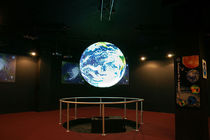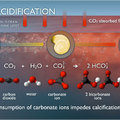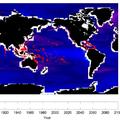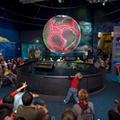Science On a Sphere
Well-crafted visualizations provide unique and powerful teaching tools
Science On a Sphere® is a large visualization system that uses computers and video projectors to display animated data onto the outside of a sphere. Researchers at NOAA developed Science On a Sphere® as an educational tool to help illustrate Earth System science to people of all ages. Animated images of complex processes such as ocean currents, sea level rise, and ocean acidification are used to to enhance the public's understanding of our dynamic environment.
Ocean Acidification on Science On a Sphere®
The movies below were developed for use on Science On a Sphere® and show computer model simulations of surface ocean pH and carbonate mineral saturation state for the years 1895 to 2094.
The first movie shows a computer recreation of surface ocean pH from 1895 to the present, and it forecasts how ocean pH will drop even more between now and 2094. Dark gray dots show cold-water coral reefs. Medium gray dots show warm-water coral reefs. You can see that ocean acidification was slow at the beginning of the movie, but it speeds up as time goes on. This is because humans are releasing carbon dioxide faster than the atmosphere-ocean system can handle.
At the same time, ocean acidification also decreases the number of carbonate ions in seawater. Scientists often track ocean acidification by measuring “omega.” This is the saturation state of calcium carbonate minerals, which is shown in the next movie below, and is important because carbonate ions are the building blocks that marine animals like corals, clams, and some algae use to make hard shells and skeletons. In this movie, areas with high omega and many carbonate ions for building shells and skeletons are in blue. Areas with lower omega and fewer carbonate ions are in orange. Areas with the lowest omega, where calcium carbonate minerals will dissolve, show up in light gray.
Ocean acidification decreases omega over time, so blue areas become lighter and then disappear. The legend shows how this affects ocean life. In blue areas with high omega, many corals and shellfish are present. In areas with medium omega that are green and yellow in the movie, fewer corals and shellfish are present. In areas with low omega that are orange or gray, corals and shellfish may be rare, injured, or gone. By 2094, the oceans will be very different from 1885, and the blue areas best for corals and shellfish will be gone.
ANIMATION: ARAGONITE SATURATION STATE
For more information, including technical information, credits, and links to download the movie, see the Science On a Sphere® website.







